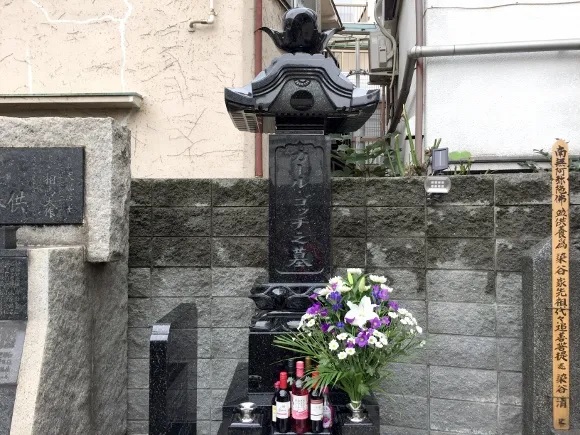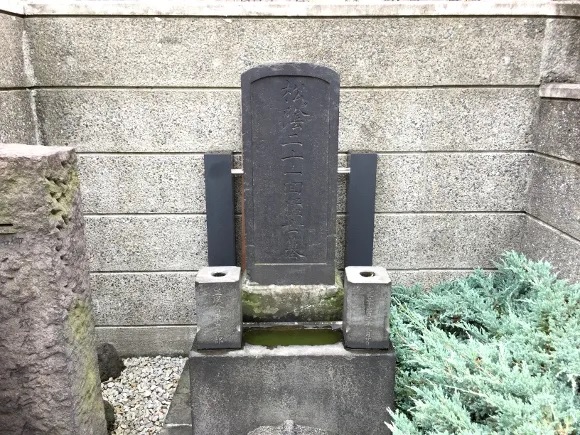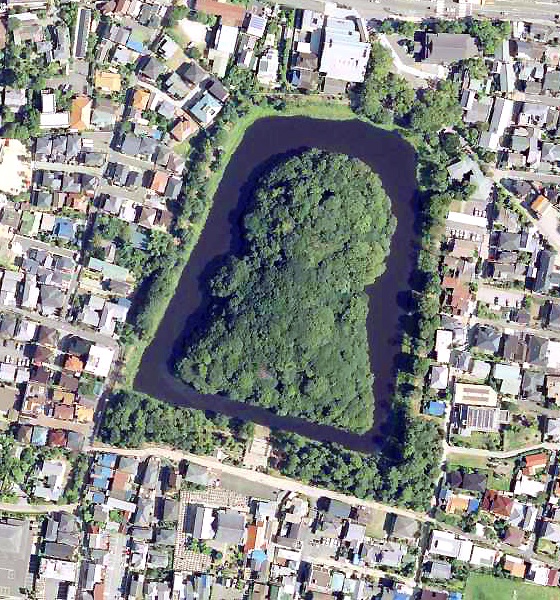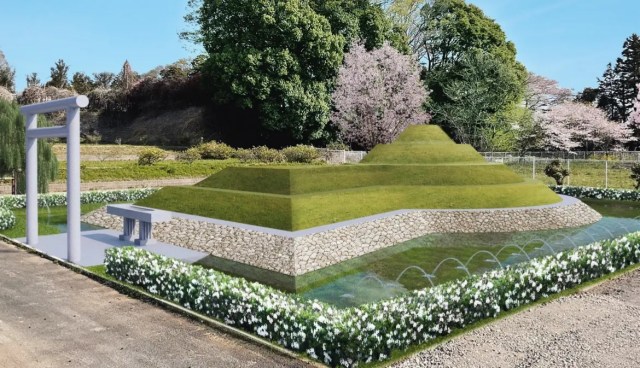
An exciting development for kofun fans.
In modern Japan, most homes are compact and in close proximity to one another…and that actually holds true for a lot of graves too. Typically, there’s a modestly sized, upright-standing headstone with spots to place incense, flowers, or other offerings, and not a whole lot else, as shown in the photos above and below.
But back in the day, final resting places could be quite a bit more opulent. For example if you passed away during Japan’s Kofun and Asuka periods (300 to 710 AD), instead of a small piece of stone on a tiny plot of land, you might have been entombed in a kofun, or burial mound.
The most prevalent type of kofun was the zenpokoenfun, in which the layout looks like a keyhole when viewed from above, with the burial mound in the middle surrounded by a moat, which is in turn surrounded by an outer layer of greenery.
▼ A zenpokoenfun in Sakai, Osaka Prefecture
Generally, you had to be a pretty big mover and shaker to be buried in a kofun, as such decadence required imperial, or at least aristocracy, levels of wealth. And in time, with land becoming more expensive and wealth more evenly distributed throughout Japanese society, kofun stopped being built entirely.
But one man is hoping to bring back the practice of building kofun, and not just for the ultra-rich and powerful. That man is Tsuneyasu Takeda, and his vision of a modern-day kofun looks like this.
Earlier this year, Takeda founded Zenpokoenfun, Inc., a startup company offering kofun design and installation services. Takeda graduated with a degree in law from Japan’s prestigious Keio University, but his true passion appears to be history, and he’s an award-winning historical and cultural researcher.
Takeda’s modern-day kofun design is between 15 and 20 meters (49.2 and 65.6 feet) in length. While that’s still much larger than the typical Japanese grave, it’s also far smaller than historical kofun that were the size of several city blocks, and Zenpokoenfun, Inc. says it will be offering its kofun at “affordable prices,” presumably meaning “not exorbatent for a plot of land that size” as opposed to “a price anyone can easily pay.” Japanese graves do tend to be communal, however, used by multiple generations of the family, so you can at least split the cost between you and your relatives.
Takeda says his motivation for starting the company is to celebrate and deepen understanding of kofun culture, and in doing so to foster feeling of thankfulness for being born in Japan, though technically it seems like purchasing a kofun would have more to do with being grateful for dying in Japan.
Pricing and order process details for the modern kofun are yet to be publicly listed, but Zenpokoenfun, Inc. is planning to reveal more details at the funerary and cemetery industry trade show which will be held on August 28 at Tokyo’s Big Sight convention center.
Source: PR Times
Top image ©SoraNews24
Insert images: SoraNews24, Wikipedia/Naokijp/Ministry of Land, Infrastructure, Transport and Tourism, PR Times
● Want to hear about SoraNews24’s latest articles as soon as they’re published? Follow us on Facebook and Twitter!




 This crazy tower in a Japanese park promises a message form aliens, so we went to get one【Travel】
This crazy tower in a Japanese park promises a message form aliens, so we went to get one【Travel】 Starbucks Japan releases new drinkware and goods for Valentine’s Day
Starbucks Japan releases new drinkware and goods for Valentine’s Day Massive manga collaboration bringing 100 years of Shueisha manga to Uniqlo T-shirts【Photos】
Massive manga collaboration bringing 100 years of Shueisha manga to Uniqlo T-shirts【Photos】 Which Japanese beef bowl chain’s near-identical demon grater onioroshi ponzu gyudon is the best?
Which Japanese beef bowl chain’s near-identical demon grater onioroshi ponzu gyudon is the best? 11 different ways to say “father” in Japanese
11 different ways to say “father” in Japanese The secret of Starbucks Japan’s Chocolate Chunk Cookie: It’s not made by Starbucks!
The secret of Starbucks Japan’s Chocolate Chunk Cookie: It’s not made by Starbucks! What’s inside the McDonald’s Japan fukubukuro lucky bag for 2026?
What’s inside the McDonald’s Japan fukubukuro lucky bag for 2026? Japanese thug wear from Birth Japan perfect for those breaking bad next year
Japanese thug wear from Birth Japan perfect for those breaking bad next year How should you respond when a Japanese person gives you a compliment?
How should you respond when a Japanese person gives you a compliment? The Yellow Lucky Bag from Village Vanguard is so bad it may damage Japan-US relations
The Yellow Lucky Bag from Village Vanguard is so bad it may damage Japan-US relations How to ride Japan’s awesome Pokémon Sandshrew Train【Photos】
How to ride Japan’s awesome Pokémon Sandshrew Train【Photos】 Starbucks Japan releases new Frappuccino and latte for Valentine’s Day
Starbucks Japan releases new Frappuccino and latte for Valentine’s Day Our 52-year-old pole dancing reporter shares his tips for achieving your New Year’s exercise goal
Our 52-year-old pole dancing reporter shares his tips for achieving your New Year’s exercise goal Ramen restaurant’s English menu prices are nearly double its Japanese ones, denies discriminating
Ramen restaurant’s English menu prices are nearly double its Japanese ones, denies discriminating Giant hotel rooms in Osaka reflect the new non-niche face of travel in Japan.
Giant hotel rooms in Osaka reflect the new non-niche face of travel in Japan. Japanese women showing rebounding interest in giving Valentine’s Day chocolate【Survey】
Japanese women showing rebounding interest in giving Valentine’s Day chocolate【Survey】 Totoro cream puffs and Catbus cookies are finally available in downtown Tokyo
Totoro cream puffs and Catbus cookies are finally available in downtown Tokyo Princess Mononoke magnets return just in time to treat yourself to awesome anime decorations
Princess Mononoke magnets return just in time to treat yourself to awesome anime decorations 10 times to avoid traveling in Japan in 2026
10 times to avoid traveling in Japan in 2026 What’s inside Starbucks Japan’s fukubukuro lucky bag for 2026?
What’s inside Starbucks Japan’s fukubukuro lucky bag for 2026? Starbucks Japan ready to get Year of the Horse started with adorable drinkware and plushies【Pics】
Starbucks Japan ready to get Year of the Horse started with adorable drinkware and plushies【Pics】 7-Eleven Japan starts new temporary luggage storage service in over 300 branches
7-Eleven Japan starts new temporary luggage storage service in over 300 branches Disillusionment at Tsukiji’s tourist-target prices led us to a great ramen restaurant in Tokyo
Disillusionment at Tsukiji’s tourist-target prices led us to a great ramen restaurant in Tokyo Starbucks teams up with 166-year-old Kyoto doll maker for Year of the Horse decorations【Photos】
Starbucks teams up with 166-year-old Kyoto doll maker for Year of the Horse decorations【Photos】 Tokyo’s Tsukiji sushi neighborhood asks tour groups to stay away for the rest of the month
Tokyo’s Tsukiji sushi neighborhood asks tour groups to stay away for the rest of the month Survey asks foreign tourists what bothered them in Japan, more than half gave same answer
Survey asks foreign tourists what bothered them in Japan, more than half gave same answer Japan’s human washing machines will go on sale to general public, demos to be held in Tokyo
Japan’s human washing machines will go on sale to general public, demos to be held in Tokyo We deeply regret going into this tunnel on our walk in the mountains of Japan
We deeply regret going into this tunnel on our walk in the mountains of Japan Studio Ghibli releases Kodama forest spirits from Princess Mononoke to light up your home
Studio Ghibli releases Kodama forest spirits from Princess Mononoke to light up your home Major Japanese hotel chain says reservations via overseas booking sites may not be valid
Major Japanese hotel chain says reservations via overseas booking sites may not be valid Put sesame oil in your coffee? Japanese maker says it’s the best way to start your day【Taste test】
Put sesame oil in your coffee? Japanese maker says it’s the best way to start your day【Taste test】 No more using real katana for tourism activities, Japan’s National Police Agency says
No more using real katana for tourism activities, Japan’s National Police Agency says Starbucks Japan reveals new sakura drinkware collection, inspired by evening cherry blossoms
Starbucks Japan reveals new sakura drinkware collection, inspired by evening cherry blossoms Updated cherry blossom forecast shows extra-long sakura season for Japan this year
Updated cherry blossom forecast shows extra-long sakura season for Japan this year
Leave a Reply